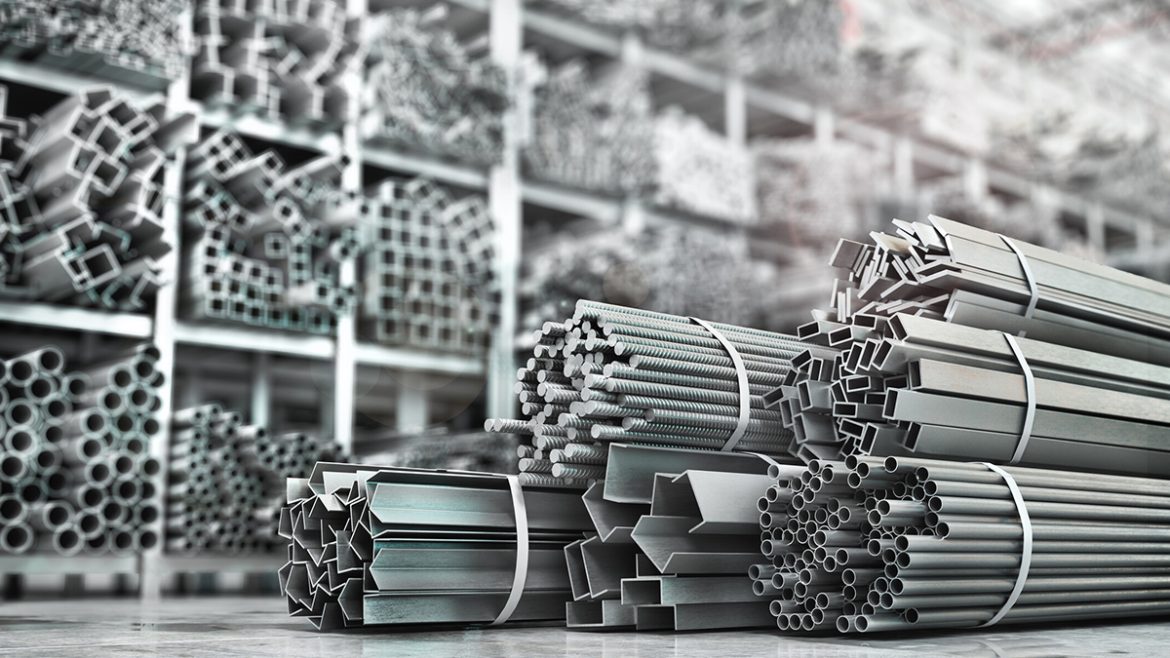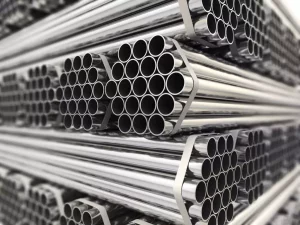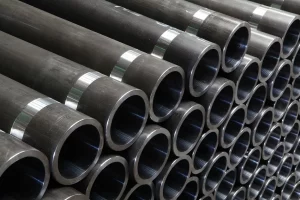Types of steel products+ steel products names

Steel products have many types and names. Many of us are familiar with steel or a product made of steel. Steel is an alloy of iron and carbon with carbon content. If the carbon content exceeds 2%, the steel becomes cast iron. The steel’s special and unique properties, such as ultimate tensile strength and relatively low cost, make it widely used in various industries such as construction, infrastructure, tools, ships, trains, cars, machinery, equipment, and military weapons. In general, products made of steel include rebar, beams, plates, pipes, profile boxes, wire boxes, wires, stud corners, sprays, and ingots. The strength of steel is directly related to the amount of dissolved carbon. The higher the carbon content, the stronger the steel, but on the other hand, increased strength reduces weldability and increases the likelihood of steel brittleness. There are more than 3500 degrees for making different types of steel. Steel can be divided into four categories according to quality: classification carbon steel, tool steel, alloy steel, and stainless steel. The criteria for this classification are chemical, physical, and environmental properties.

These different types of steel are classified according to type of use and quality. In general, steel can be divided into the following four types:
- carbon steel
- alloy steel
- Stainless steel
- tool steel
Each of these steels has its own uses and properties. Each of these categories is divided into different subcategories. Taking alloy steel as an example, the alloy formula provides a range of products in this industry. In addition, according to the use of stainless steel, its degree of rust and production formula can be completely changed, there are mainly more than 6 kinds.
types of steel products
Many types of steel products are on the market. We know that there are 3,500 different types and qualities of steel, but the placement of each of these qualities in the steel classification is a very broad question that needs to be examined from branch to branch. To that end, in this article, we present some examples of ways to classify different types of hardware and name their subgroups.
- Alloy elements
One of the most scientific classifications of steel is the type of alloying elements in it. Although this classification is not very commercially effective, and the terms used to describe its type in the market are sometimes different and sometimes incorrect, we will briefly introduce this classification in this article and then proceed to the classification. More common:
- A) Carbon steel
This steel has a high carbon content ranging from 0.12% to 1.2%. The amount of alloying elements such as chromium, nickel, cobalt, vanadium and molybdenum. In this type of steel, it is almost zero. The maximum content of copper is 0.4% by weight. It is also divided into three main categories based on the amount of carbon:
- mild steel
- Carbon steel
- High carbon steel
- B) Stainless steel
This steel is the opposite of carbon steel in terms of oxidative power. The main alloying elements of this type of steel are chrome and nickel. There are several types of stainless steel on the market known as steel. However, the types of phases this steel forms during solidification provide a more general classification:
- Stainless steel martensitic stainless-steel martensite
- Ferrite in stainless steel
- Austenitic stainless steel
- Duplex (containing ferrite and austenite phase) duplex
- C) alloy steel

This type of steel is, as the name suggests, steel made of various metals and non-metallic alloys such as nickel, chromium, molybdenum, vanadium, silicon, boron, and cobalt, copper, niobium, tungsten, tin, zinc, lead, etc. Zirconium and several other elements. If stainless steel differs from carbon steel only in the discussion of corrosion and oxidation, alloy steel also differs in other properties. Properties such as strength, hardness, toughness, abrasion resistance, hardness, and high-temperature service are such properties.
steel products names
steel products have different names that we mentioned in the text below.
rebar
Reinforcing steel is one of the most widely used steels in the construction industry and urban infrastructure, and one of the reasons for using it is to increase the strength of the concrete against tensile and rotational forces. Reinforcement production and supply of two types of simple rebar and rebar of A1, A2, A3, and A4 standards. Reinforcing bars are classified into ribbed and simple types according to their appearance, production method, and application. Grades A2, A3, and A4 belong to ribbed steel rods, and class A1 belongs to ordinary steel rods. There are three calculation characteristics of yield stress, spatial structure, and tensile strength when installing steel reinforcement in buildings.
beam
If we want to give a general and comprehensive definition of the beam, we must say that the main component of steel frame construction is the beam. In fact, it is impossible to build a steel structure without beams. Beams are responsible for carrying the load of the building and transferring the load to the building. The two main parts of the beam are the soul and the wings. In the center is the main part of the beam, called the soul, and the sides and sides are called the wings. under construction. There are different types of beams and there are many types. Most of their variation is in appearance as well as in their mechanical properties.
A steel plate is a product with a smooth and flat surface, usually made of steel. The steel product is manufactured at the factory by both hot and cold rolling.
Black steel sheet
From the name of the black sheet, it appears to be a black sheet, but it is not. Because the paper lacks gloss and polish, it is called black. This plate is made by the hot-rolling method. Chalkboards can be used in bodywork, car floors, folded pipes, profiles, staplers, and shipbuilding.

Sheets
As with the black sheets, this sheet does not get its name because of its oiliness, but because of the smoothness and smoothness of the name. This plate is also made by cold rolling.
Oily plates can be used in these cases. It is a plate used in the manufacture of the galvanized plate for the production of household appliances such as stoves or refrigerator lids. This sheet is also used to make pipes.
sheets
The color sheet is actually the same galvanized sheet with a coating of electrostatic paint. Colored paper is available in 15 color variants. Slabs of this type are commonly used in the production of canopies, gazebos, and ceilings, in the production of household and office equipment, and in the manufacture of refrigeration and heating equipment.
The main uses of colored sheets in the construction industry, such as roofs and interior and exterior facades of buildings, are in the manufacture of household appliances in the transport industry, such as car spaces, heavy vehicles, etc.
Profile box
Profile tanks arise for their many special uses in the construction industry and in various industries. Mentioned in the range of steel products of great importance and use. The most important applications for profiled tanks are weldability, high surface quality, great variation, and high shape and formability.
Types of wire products
Wire products are also divided into different types, each with its own application.
Types of wire products include:
- metallic line
- blonde
- barbed wire
black sheet, it appears to be a black sheet, but it is not. Because the paper lacks gloss and polish, it is called black. This plate is made by the hot-rolling method. Chalkboards can be used in bodywork, car floors, folded pipes, profiles, staplers, and shipbuilding.
Galvanized sheet
Steel plates are subject to corrosion and rust, and since it is not cost-effective to produce corrosion-resistant stainless-steel plates, they use a method called galvanizing. Galvanized sheet is used in the production of water pipes, the production of cabinets, and storage tanks, and in the production of canopies.
colorful sheets
The color sheet is actually the same galvanized sheet with a coating of electrostatic paint. Colored paper is available in 15 color variants. Slabs of this type are commonly used in the production of canopies, gazebos and ceilings, in the production of household and office equipment and in the manufacture of refrigeration and heating equipment.

The main uses of colored sheets in the construction industry, such as roofs and interior and exterior facades of buildings, are in the manufacture of household appliances in the transport industry, such as car spaces, heavy vehicles, etc.
Profile box
Profile tanks arise for their many special uses in the construction industry and in various industries. Mentioned in the range of steel products of great importance and use. The most important applications for profiled tanks are weldability, high surface quality, great variation, and high shape and formability.
Types of steel pipes
Steel pipes are divided into different types, each of which is divided into different categories and has its own unique application. Below we will list the types of steel pipes.
- industrial pipeline
- gas pipes
- Industrial galvanized pipe
- Galvanized water test tube
types of steel
There are many different types of steel products in the market. But the models’ number 2 and 5 are the most important ones that we are not going to talk about them here. There are many ways to name steel, the most prominent of which is the DIN standard. This standard belongs to Germany and is one of the leading standards in metallurgy. The nomenclature is based on the use of steel, and its physical and mechanical properties. In order to facilitate the identification of steel named in accordance with this standard,

The following letters and codes must be considered: St steel refers to structural steel, which usually represents a number after St, indicating the ultimate strength of the steel, in kilograms per square millimeters, and if it is in MPa, multiply the number by 9.8.
If the letter R is placed before the theorem St, it means that impurities and gases have been removed again from the steel, which will result in higher quality steel.
Such as st37 steel alloy showing ordinary structural steel, the minimum tensile strength is 37 kg / mm2 or 370 MPa. According to the American Iron and Steel Institute, steel is divided into four main categories based on its chemical composition:
- Carbon steel
- steel
- Stainless steel
- steel tools
Carbon steel is divided into the following categories:
Mild steel: In this type of steel, the carbon content is less than or equal to 0.1. The lower the percentage of carbon in the steel, the more characteristic the iron phase.
Therefore, mild steel is very soft and tough. Mild steel is used to make tension wires. Mild steel can be easily cold-formed. Mild steel crystals slide easily together to form new metallic bonds with subsequent rows of crystals. As a result, in addition to maintaining its strength, the steel takes on a new shape.
Medium carbon steel (mild): Steel with a carbon content of 0.1 to 0.3 is called medium carbon steel.
In addition to being softer, medium carbon steel has higher tensile strength than mild steel due to the effect of carbon on steel strength. Carbon steels contain manganese, phosphorus, sulfur, silicon, and other elements.
Ordinary carbon steel: In this type of steel, carbon is between 0.3 and 0.6. The hardness of this type of steel is good and hard steel can be made by adding alloying elements like chromium and nickel. But they are not ductile compared to mild steel and medium carbon steel.
High carbon steel: Steel with a carbon content between 0.6 and 1.7 is called high carbon steel. The high carbon content of this steel makes it brittle. If carbon is added, the tensile strength and impact resistance will be very low, especially at low temperatures. The weldability of the steel is also reduced.
You can contact us to buy and sell this product:
Sales consultant: Ms. Leila Nematzadeh
Ways of communication: Phone number: 02147623014
Phone number: 02147623014
 Phone number: 04133660491
Phone number: 04133660491
 Phone number: 09120169267
Phone number: 09120169267
 WhatsApp Response (Skype): click
WhatsApp Response (Skype): click
 Instagram: simurgh_steel_company@
Instagram: simurgh_steel_company@
 email: info@simurghsteelco.com
email: info@simurghsteelco.com
 email: ironore110@gmail.com
email: ironore110@gmail.com
 Facebook: ironore110@
Facebook: ironore110@
 LinkedIn: simurgh-iron-and-steel-company-a68295180@
LinkedIn: simurgh-iron-and-steel-company-a68295180@
 twitter: CoSimurgh@
twitter: CoSimurgh@

 Call number:
Call number:  Whats app:
Whats app:  Address: Salimi industrial Park, Tabriz, IRI
Address: Salimi industrial Park, Tabriz, IRI Instagram:
Instagram:  email:
email:  Facebook:
Facebook: 









